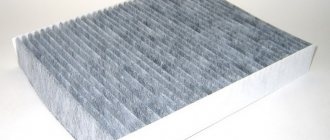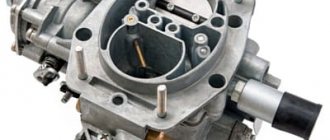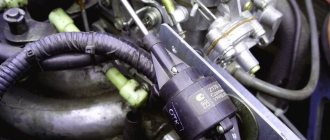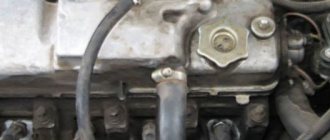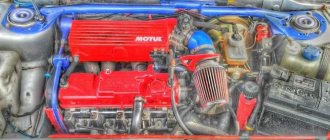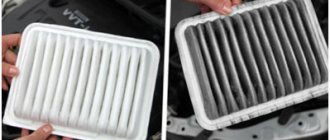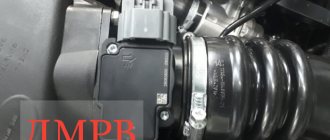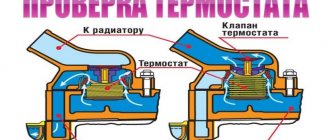Air leaks in the intake manifold are a common problem that manifests itself in unstable engine operation. Intake leakage leads to serious malfunctions; signs of air leakage in the intake manifold:
- the engine runs unevenly;
- the power unit shakes;
- RPM fluctuates.
However, it can be difficult to detect the area where air is being sucked in. For this reason, it is important to know how to check for air leaks in the intake manifold, as well as in the engine as a whole. Read more in our article.
Clear signs that the engine is sucking air, how to detect and fix it yourself
Hello, dear readers!
I think you know how an injector works in brief. It automatically makes the air-fuel mixture. Thanks to the sensors, the system works perfectly. If the sensor fails, the system malfunctions and the engine begins to “trouble.”
And if all the sensors are working properly, but the engine is still not working correctly, what could it be?
The most popular reason is air leaking into the system.
Air that does not pass through the mass air flow sensor is called unaccounted for. Accordingly, the engine will no longer work properly.
Signs that the engine is sucking air are:
1. Unstable operation at idle.
2. Dips when starting to move.
3. Cravings have gotten worse.
4. Fuel consumption has increased.
5. The Check light may be on.
As a rule, the main symptom is unstable engine operation at idle.
How can I find out on my own where the air is leaking?
There is special equipment called a smoke generator device. Its principle is that smoke under pressure is released into the system and it begins to escape from the place where the system is not sealed.
Most often, this happens at the installation sites of injectors or sensors. As a rule, the problem is solved by replacing the O-rings. Over time, they become stiff and air begins to leak.
You don’t have to buy a smoke generator; it’s quite easy to make it yourself. Look what we need for this:
Plastic container, cigarette, two tubeless nipples, compressor for inflating wheels, hose.
We cut tubeless nipples into the container on both sides. We leave the spool on one side.
We connect the second hose to the intake manifold:
The mass air flow sensor should be removed and the air supply closed. You can use anything for this, say a package. In this case, a balloon was used.
Now we light a cigarette and insert it into the hose, close the lid and turn on the compressor:
It remains to be seen where the smoke will come from:
This way, you will know exactly where the air leak occurs and where the depressurization occurred.
We fix the problem, check it again with a smoke generator and are glad that we repaired the car ourselves.
Source
Revealing
Let's look at different ways to detect air leaks into the engine through the injectors.
Spraying
Signs of suction are determined by spraying water (using a syringe) onto the hoses of a running engine. Liquid getting into cracks, holes, cracked hoses or a broken gasket causes a decrease in engine speed.
Another similar method is used to irrigate the same segment of nodes with ether, which leads to an increase in speed. So, when identifying leak points, you should carefully monitor the cleanliness of the engine. To find the location of the leak, you can use the measurement of the degree of vacuum behind the throttle. In this case, the removed hose is connected to the throttle valve control element.
Video about identifying leaks using the spraying method
Smoke or steam generator
The device detects leaks in internal cavities where there is air. Closing the throttle valve with some kind of plug, connect it to the intake manifold. Streams of smoke begin to leak through leaks and cracks.
Checking air leaks using a smoke generator
The device also checks for leaks in the exhaust system by plugging the exhaust pipe of the muffler. This is achieved by setting the piston of any cylinder to TDC and ensuring that the valves overlap. In this case, the smoke, having passed the open valves, flows into the exhaust system, revealing defects in the density of this area. For this purpose, the engine is started and in idle mode the possible appearance of a hiss or a specific whistle is heard.
Video about checking air leaks using a steam generator
Possible faults
Knowing possible areas of leakage, faults are identified:
- Crack in the exhaust valve connection.
- Blown manifold gasket.
- Throttle gaskets.
- Vacuum booster, hoses.
- Problems with the IAC cover (rear).
- Sleeves from the air filter to the throttle body.
- Injector seals.
- Receiver plug.
- Canister valve.
- Fuel pressure sensor diaphragm.
If you do not hear any sounds, you can begin the process of pinching the hose going to the intake manifold.
By squeezing the sleeves of the VUT (vacuum brake booster) or mixture pressure regulator, you can hear stable engine operation. When you remove the tool (pliers), you feel a drop in speed. This defect indicates the presence of holes or cracks in the hose being tested. There may be malfunctions of the amplifier or the adsorber valve.
How does air leakage affect the operation of the VAZ 2114 engine?
- Registration
- Entrance
- To the beginning of the forum
- Forum Rules
- Old design
- FAQ
- Search
- Users
Good afternoon! I want to look for air leaks in the engine this evening. According to all the symptoms, he is there somewhere. The question is by what means to look for it and in what places? Maybe later this information will be useful to someone, but first of all to me. This leaves three questions: 1. Where are the most likely places for air leaks? 2. How to determine (diagnose)? 3. How to treat?
One of the ways you buy carb cleaning fluid. and carefully water all the joints, if the speed starts to float somewhere, then there is a hole there
Just don’t pour on the release or you’ll burst into flames.
You can water it with something flammable - revs up means suction here, enrichment is not provided.
Consequences of air leaks
An air leak will cause unwanted air to enter the engine where it is not intended. This reduces engine performance and causes some systems that rely on vacuum to malfunction.
Because air leaks cause engine inefficiency, you will notice the "Check Engine" light on your dashboard. You will also experience acceleration problems - this is because fuel is not delivered efficiently to the combustion chambers. Vacuum is used to operate actuators, sensors or brakes.
If there is a vacuum leak, some of the sensors may begin to malfunction, forcing you to make unnecessary repairs.
Engine Inspection
To identify air leaks, you must first understand how the engine intake system works.
Air enters through the air filter. The throttle valve controls it by creating a vacuum. Know that a car is leaking air when it makes a hissing sound after starting.
Vacuum hoses wear out during operation and become brittle. This leads to their damage. Carefully inspect the hoses on the engine and replace them if necessary. The engines are different from each other. Refer to the repair manual for hose identification.
Troubleshooting
You can easily and clearly detect air leaks in the intake manifold using a smoke generator.
The most accessible way to find air leaks in the intake manifold is a visual inspection. Cracks and breaks in air hoses can be seen with the naked eye. You can also check how tightly the parts are connected to each other. It often happens that during repairs, for example, the nuts securing the carburetor or other components were not properly tightened. If there are no visible causes of malfunctions, then spraying “Quick Start” type compositions made on the basis of ether from a can along the joints of parts is very effective. The procedure must be carried out with the engine running. Ether that gets into the manifold through the cracks will cause changes in the operation of the motor - its speed should increase briefly. Finally, the question of how to detect air leaks in the intake manifold is easy to resolve if you have a smoke generator. With its help, finding places of leakage does not present any special problems. Having “pumped” the intake tract with smoke, you can visually observe where the integrity of the intake system is compromised - in this case, it is better to use a blue lamp (flashlight) - in its light it becomes more noticeable.
Leaks in the intake manifold
If your hoses are fine, the problem may be with the intake manifold. The intake manifold gasket leaks from time to time, causing air leaks. It is located between the cylinder head and the manifold.
To check the tightness of the intake manifold, place the car on the handbrake. Start the engine and let it idle for a few minutes.
Apply the soap solution to the area between the intake manifold and the cylinder head or at the base of the carburetor. Listen to the sound coming from the engine. If it is smoothed out, then air leaks occur at the intake manifold and require repair.
POSSIBLE LEAKING POSITIONS IN THE INDUCTION TRACT
Air leak in the intake system, how to detect?
All tubes and hoses of the vacuum system. Most often, hoses dry out at the connection points with fittings and crack at bends.
Also, the leakage of unaccounted for air can occur due to carelessness, when after repairs they forget to connect or confuse the hoses, or inadvertently pull them off the fittings. Vacuum brake booster system. Air leaks can occur not only through a check valve or hose, but also through a torn membrane, depressurization of the vacuum chamber housing
We have already looked at how to check the VUT. Intake manifold gasket. Sealing rubber bands for injectors.
- IAC seal at the point where it is screwed to the DZ housing.
- Mechanical throttle valve rotation axis. The depletion that occurs at high mileage leads to the appearance of backlash. Throttle valves with an electric wire do not suffer from the problem of suction of unaccounted air in such places.
- Crack in the intake manifold. A fairly typical problem for cars with plastic manifolds.
- Crankcase ventilation system. The cause of suction is leakage of hoses, tubes, and valves.
- Leakage of the gas tank ventilation system.
USING THE DIAGNOSTIC DEVICE
The scanner allows you to identify additional symptoms indicating that the cause of unstable idle speed is air leaks. The device will allow you to observe in real time:
- lambda probe readings;
- throttle valve opening degree;
- idle speed control position;
- desired and actual idle speed;
- long-term and short-term fuel trims.
In the video, a diagnostic specialist explains exactly how to use these values to diagnose air leaks in the engine.
https://youtube.com/watch?v=8abNP9WN_EU
https://youtube.com/watch?v=v4t4rqSmXG0
LOCALIZING THE CAUSE
Let's look at the main methods for determining the cause of air leaks without using a smoke generator.
- Splashing of carburetor cleaner near the intake tract elements. Cleaners contain easily volatile and flammable components. Getting into the cylinders through the air intake point, the cleaner enriches the fuel mixture. In particularly critical cases, at such moments a short-term increase in engine speed is observed. But it is much more reliable to observe short-term fuel correction using a diagnostic tool during the test. The values will rise when the cleaner is sucked in, as the lambda probe will register an enrichment of the mixture.
- Splashing water. The purpose of the test is to hear the characteristic sound of water being sucked in, which will definitely happen at the point of air leakage. For convenience, fill the bottle with water after making a small hole in the lid. Generously water the connection points of the vacuum system hoses, if possible the junction of the cylinder block and the intake manifold. Check the area after the throttle valve with special care, as this is where the vacuum and the risk of suction are highest. But you shouldn’t completely fill the engine with cold water, especially the exhaust manifold. A sudden change in temperature can lead to cracking.
SMOKE GENERATOR TEST
The point of the test is to supply smoke into the intake tract. In places where air is leaking, smoke will come out, which will localize the leak. You can buy a smoke generator or build the device yourself. There are plenty of different design options on the Internet, one of which is shown in the video below.
How can I use a smoke generator to find the place where air is leaking?
- Block the inlet pipe in front of the air filter. If this is not done, the smoke pressure in the intake tract will increase slowly.
- Disconnect one of the available vacuum system hoses and connect the smoke generator hose instead.
Use a compressor to supply smoke. When the system is completely filled, you just have to watch for smoke leaks, which can cause unaccounted air to leak into the intake manifold.
Symptoms of air leaks
The first sign of air leaks is the Check Engine light coming on. There are many reasons to turn on this light bulb. You'll need to rule out other problems before you decide it's a leak. But be sure that it is an air leak if it is accompanied by hissing from the engine and loss of power.
Is your car not developing full power? It could be an air leak.
Leaking can cause additional engine problems such as fuel inefficiency.
Vacuum hose repair
If your vacuum hose is damaged, you don't have to buy a new one. The hose is long. You can cut off the damaged part and reattach it to the engine.
The most common damage is at the ends of the tubes. Always ensure that the clamps are tight to prevent further leaks.
After repairs, start the engine and leave it idling. Listen for any hissing sounds.
If you decide to replace the vacuum hose, use one that is similar in length and diameter. Vacuum tubes are designed for specific locations, such as the brake booster or PCV (Power Crankcase Ventilation) system.
Diagnostic methods
The engine's refusal to idle is a consequence of a lean mixture, caused by excess air in the fuel line.
This is accompanied by:
- Rusty fuel supply pipes.
- Fuel hoses that have dried out as a result of long use and are no longer held in place by clamps.
- Fuel filter with seal defects.
- Exhaust pipes that have lost their seal.
- Injection pump seals.
- Air entering through the manual lever of the fuel pump.
- Fuel pump seals.
- Obsolescence of seals.
First way
Diagnosis of the defect involves turning off the fuel pump and powering it from another vessel (for example, a plastic canister) . Independent work will require a 3÷4 liter container, two transparent hoses, one meter long, and a pair of clamps. Observing cleanliness measures, the forward and return fuel lines from the injection pump are replaced with transparent tubes, and the air is removed from it.
One of the ways to remove suction is to clean the place of work and the location of the tank above the fuel pump . It is necessary to unscrew the “return” bolt, through which, according to the principle of a siphon, air escapes before fuel appears. The fitting bolt returns to its place. Running the engine for a few minutes removes any remaining air.
Video about diagnosing the fuel pump for air leaks
Second way
It consists of testing the fuel filter (standard), placing it below the injection pump . The method is focused on determining suction through a filter. If there is no result, all tubes, tank, and hoses are checked. This method of powering gives precise indications of difficulty starting the engine.
The origin of leaks in the fuel system of cars with a diesel engine is based on atmospheric pressure. It is higher than the pressure that is created when pumping fuel from a car tank. This is due to the replacement of brass fuel lines with rubber and plastic tubes and connecting them with clamps. Meanwhile, hoses made of such materials have a shorter service life. Reference is made to the fact that synthetic pipes in the engine compartment heat up, sag, rub, and, as they wear out, contribute to air leakage .
Thus, mechanical stress, overheating, and the use of cleaning agents capable of softening non-metallic materials and hermetic compounds can be attributed to the root causes of suction.

